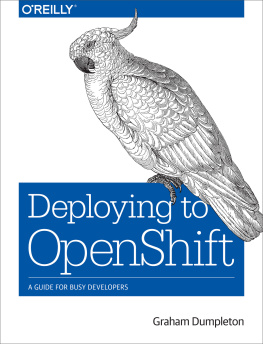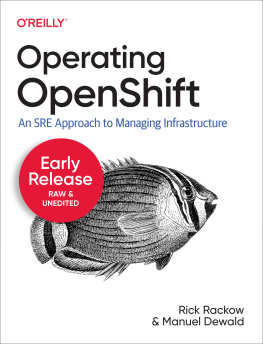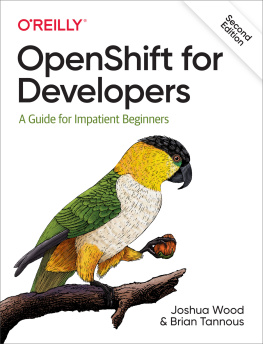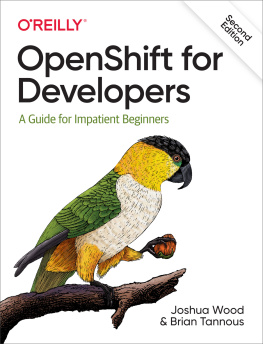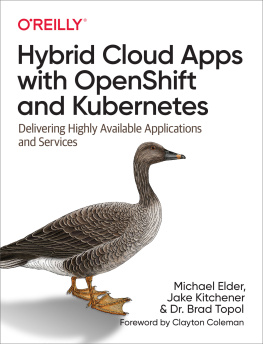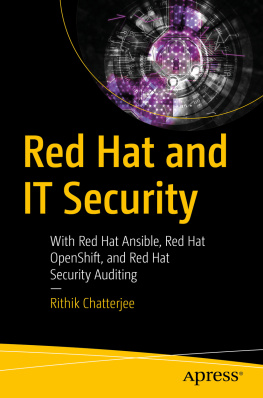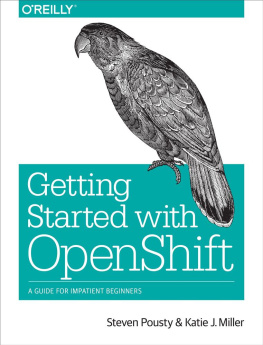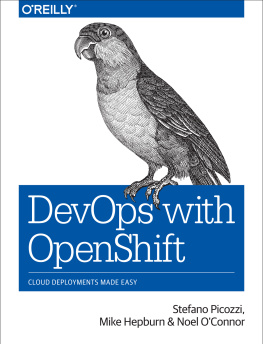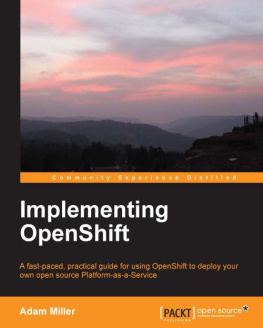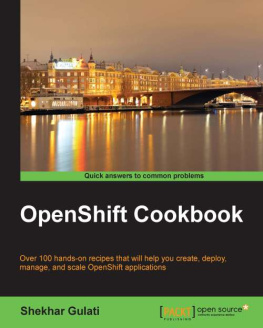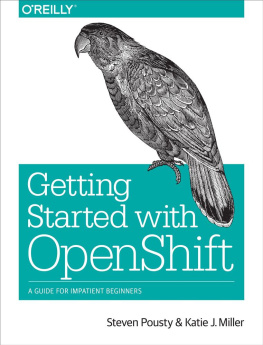Graham Dumpleton - Deploying to OpenShift
Here you can read online Graham Dumpleton - Deploying to OpenShift full text of the book (entire story) in english for free. Download pdf and epub, get meaning, cover and reviews about this ebook. year: 2018, publisher: OReilly Media, genre: Computer. Description of the work, (preface) as well as reviews are available. Best literature library LitArk.com created for fans of good reading and offers a wide selection of genres:
Romance novel
Science fiction
Adventure
Detective
Science
History
Home and family
Prose
Art
Politics
Computer
Non-fiction
Religion
Business
Children
Humor
Choose a favorite category and find really read worthwhile books. Enjoy immersion in the world of imagination, feel the emotions of the characters or learn something new for yourself, make an fascinating discovery.
- Book:Deploying to OpenShift
- Author:
- Publisher:OReilly Media
- Genre:
- Year:2018
- Rating:5 / 5
- Favourites:Add to favourites
- Your mark:
- 100
- 1
- 2
- 3
- 4
- 5
Deploying to OpenShift: summary, description and annotation
We offer to read an annotation, description, summary or preface (depends on what the author of the book "Deploying to OpenShift" wrote himself). If you haven't found the necessary information about the book — write in the comments, we will try to find it.
Deploying to OpenShift — read online for free the complete book (whole text) full work
Below is the text of the book, divided by pages. System saving the place of the last page read, allows you to conveniently read the book "Deploying to OpenShift" online for free, without having to search again every time where you left off. Put a bookmark, and you can go to the page where you finished reading at any time.
Font size:
Interval:
Bookmark:
by Graham Dumpleton
Copyright 2018 Red Hat, Inc. All rights reserved.
Printed in the United States of America.
Published by OReilly Media, Inc. , 1005 Gravenstein Highway North, Sebastopol, CA 95472.
OReilly books may be purchased for educational, business, or sales promotional use. Online editions are also available for most titles (http://oreilly.com/safari). For more information, contact our corporate/institutional sales department: 800-998-9938 or corporate@oreilly.com .
- Editors: Virginia Wilson and Nikki McDonald
- Production Editor: Melanie Yarbrough
- Copyeditor: Dwight Ramsey
- Proofreader: Rachel Head
- Indexer: Judy McConville
- Interior Designer: David Futato
- Cover Designer: Karen Montgomery
- Illustrator: Rebecca Demarest
- April 2018: First Edition
- 2018-05-02: First Release
This work is part of a collaboration between OReilly and Red Hat. See our statement of editorial independence.
The OReilly logo is a registered trademark of OReilly Media, Inc. Deploying to OpenShift, the cover image, and related trade dress are trademarks of OReilly Media, Inc.
While the publisher and the author have used good faith efforts to ensure that the information and instructions contained in this work are accurate, the publisher and the author disclaim all responsibility for errors or omissions, including without limitation responsibility for damages resulting from the use of or reliance on this work. Use of the information and instructions contained in this work is at your own risk. If any code samples or other technology this work contains or describes is subject to open source licenses or the intellectual property rights of others, it is your responsibility to ensure that your use thereof complies with such licenses and/or rights.
978-1-491-95716-5
[LSI]
OpenShift implements a polyglot platform for the deployment of web applications and services. It uses containers in conjunction with a Security-Enhanced Linux (SELinux) environment to implement a secure multitenant environment suitable for the enterprise. You can deploy OpenShift in your own infrastructure or on public clouds, or you can use OpenShift Online, Red Hats cloud-based hosting service.
The latest version of OpenShift uses the industry-standard Kubernetes platform from the Cloud Native Computing Foundation (CNCF) for managing and running applications within containers at scale. The ability to run any application image is ensured through adherence to image and runtime specifications from the Open Container Initiative (OCI).
OpenShift offers you the ability to easily deploy your web application code directly using a library of predefined image builders, or you can bring your own container images. With support in OpenShift for features such as persistent volumes, you are not limited to just running stateless 12-factor or cloud-native applications. Using OpenShift, you can also deploy databases and many legacy applications that you otherwise would not be able to run on a traditional Platform as a Service (PaaS) offering.
OpenShift is a complete container application platform. It is a modern take on the traditional PaaS that you can use with your existing applications, but that also provides the power and flexibility to meet future needs.
This book is intended for developers who are evaluating OpenShift, or have already decided to use it, and who seek a more in-depth knowledge of the core features of OpenShift that are used to deploy applications. It will also be of interest to administrators who are managing an OpenShift cluster and who need to provide assistance to developers using the platform.
The book is the third in a series of books from Red Hat about the latest version of OpenShift. The prior books in the series are:
OpenShift for Developers: A Guide for Impatient Beginners
DevOps with OpenShift: Cloud Deployments Made Easy
The first book, OpenShift for Developers, which I coauthored with Grant Shipley, aimed to get you started as quickly as possible by skipping many of the details. Those details are important, though, when you want to make the most of OpenShift. In this book I wanted to fill in some of those gaps to give you that broader understanding of OpenShift and how it can make your job of deploying applications to the cloud easier.
The topics I have chosen for the book are based on my experience of having to answer many a question on public community forums (such as Stack Overflow and Google Groups) and at conferences, in my role at Red Hat working as a Developer Advocate for OpenShift.
The aim is that this book will act as a quick reference guide you can keep coming back to in order to refresh your memory on commonly used patterns, or to learn more about additional topics as you continue to use OpenShift.
As with many new technologies, OpenShift is still evolving as it adapts to the wide range of use cases it is applied to. When you come to read this book, some information may not provide the most up-to-date picture. Thats why we encourage you to check online resources for the latest details on OpenShift and how to use it.
The OpenShift documentation is a great place to start when youre looking for information about OpenShift, from OpenShift Online to Red Hats enterprise products.
To learn more about OpenShift by working through online training exercises, you can use the interactive learning portal for OpenShift, implemented on top of Katacoda.
To run OpenShift Origin locally on your own computer in a virtual machine, you can use Minishift.
If you are interested in the source code for OpenShift, it is available via the OpenShift Origin project.
OpenShift Origin is the upstream open source project that is used to create the Red Hat OpenShift product range. OpenShift Origin will always include all the latest features, including experimental features, with support being provided by the OpenShift community. You are warmly invited to clone the OpenShift Origin project code, send in your contributions, or open an issue to report any problems you find.
The OpenShift product releases are created as regular snapshots of the OpenShift Origin project. The product releases do not always have the very latest features enabled, but if you have a commercial Red Hat subscription, the product releases include support from Red Hat.
If you would like to try out the OpenShift enterprise products, a number of options are available.
The first is to sign up to the Red Hat Developers Program. This is a free program and allows you to access versions of Red Hat products for personal use on your own computer. One of the products made available through the program is the Red Hat Container Development Kit. This includes a version of OpenShift that you can run inside a virtual machine on your own computer, but which is based on the OpenShift Container Platform product rather than OpenShift Origin.
A second way of trying out OpenShift Container Platform is via a free test drive with the leading cloud service providers. This will set you up an OpenShift environment running across a multinode cluster on the cloud provider of your choice.
Like what you see and just want to get your website out there and being used, without needing to set up and run your own OpenShift cluster? Check out OpenShift Online, Red Hats public cloud-based hosting service.
Want to hear about how others in the OpenShift community are using OpenShift, or wish to share your own experiences? You can join OpenShift Commons.
Font size:
Interval:
Bookmark:
Similar books «Deploying to OpenShift»
Look at similar books to Deploying to OpenShift. We have selected literature similar in name and meaning in the hope of providing readers with more options to find new, interesting, not yet read works.
Discussion, reviews of the book Deploying to OpenShift and just readers' own opinions. Leave your comments, write what you think about the work, its meaning or the main characters. Specify what exactly you liked and what you didn't like, and why you think so.

